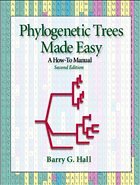Nicht lieferbar

Phylogenetic Trees Made Easy
Versandkostenfrei!
Nicht lieferbar
'Phylogenetic Trees Made Easy' helps beginners get started in creating phylogenetic trees from protein or nucleic acid sequence data. Although aimed at molecular and cell biologists who may not be familiar with phylogenetic or evolutionary theory, it also serves students who may be familiar with phylogenetic theory but are unfamiliar with the tools used to apply that theory. The reader is led, step-by-step, through identifying sequences that are homologous to a sequence of interest, downloading these sequences from databases, creating multiple alignments and using several different methods to ...
'Phylogenetic Trees Made Easy' helps beginners get started in creating phylogenetic trees from protein or nucleic acid sequence data. Although aimed at molecular and cell biologists who may not be familiar with phylogenetic or evolutionary theory, it also serves students who may be familiar with phylogenetic theory but are unfamiliar with the tools used to apply that theory. The reader is led, step-by-step, through identifying sequences that are homologous to a sequence of interest, downloading these sequences from databases, creating multiple alignments and using several different methods to construct trees. Key changes to the Second Edition include: content and screen shots have been updated to reflect current software versions; new "Advanced Topics" to extend understanding; detailed discussion of PAUP* as well as inclusion of PHYLIP as an alternative. Every copy of the Second Edition also includes a CD with current Windows and Macintosh beta versions of PAUP*.
Contents:
INTRODUCTION: READ ME FIRST
A Brief Overview of the Second Edition
Learn More about the Principles
Computer Programs Discussed and Where to Obtain Them
Download Files and Utilities from the Website
Some Conventions Used in This Book
PART 1: TUTORIAL: CREATE A TREE!
Why Create Phylogenetic Trees?
Obtaining Related Sequences by a BLAST Search
Creating the Multiple Alignment
Phylogenetic Analysis
Drawing the Tree Using TreeView
Summary
PART 2: BASIC ELEMENTS IN CREATING AND PRESENTING TREES
Selecting Homologs: What Sequences Can Be Put onto a Single Tree?
Fine Tuning Alignments
Major Methods for Creating Trees
Data Files Used to Illustrate Methods
Using PAUP* to Create Trees
Creating Maximum Likelihood Protein Trees Using Puzzle
Creating Bayesian Trees Using MrBayes
Presenting and Printing Your Trees
Choosing What Form of a Tree to Publish
Making a Tree Pretty: Not Just a Cosmetic Matter
DNA or Protein Phylogenies: Which Is Better?
PART 3: ADVANCED ELEMENTS IN CONSTRUCTING TREES
Reconstructing Ancestral DNA Sequences
Using Protein Structure Information to Construct Very Deep Phylogenies
Analyzing Trees for Evidence of Adaptive Evolution by Detecting Positive Selection in a Phylogeny
PART 4: USING ALTERNATIVE SOFTWARE TO CONSTRUCT AND PRESENT TREES
Using PAUP* on a Windows or UNIX computer
Using PHYLIP
Appendix I: File Formats and Their Interconversion
Appendix II: Printing Alignments
Literature Cited
Index to Major Programs Discussed
Subject Index
Contents:
INTRODUCTION: READ ME FIRST
A Brief Overview of the Second Edition
Learn More about the Principles
Computer Programs Discussed and Where to Obtain Them
Download Files and Utilities from the Website
Some Conventions Used in This Book
PART 1: TUTORIAL: CREATE A TREE!
Why Create Phylogenetic Trees?
Obtaining Related Sequences by a BLAST Search
Creating the Multiple Alignment
Phylogenetic Analysis
Drawing the Tree Using TreeView
Summary
PART 2: BASIC ELEMENTS IN CREATING AND PRESENTING TREES
Selecting Homologs: What Sequences Can Be Put onto a Single Tree?
Fine Tuning Alignments
Major Methods for Creating Trees
Data Files Used to Illustrate Methods
Using PAUP* to Create Trees
Creating Maximum Likelihood Protein Trees Using Puzzle
Creating Bayesian Trees Using MrBayes
Presenting and Printing Your Trees
Choosing What Form of a Tree to Publish
Making a Tree Pretty: Not Just a Cosmetic Matter
DNA or Protein Phylogenies: Which Is Better?
PART 3: ADVANCED ELEMENTS IN CONSTRUCTING TREES
Reconstructing Ancestral DNA Sequences
Using Protein Structure Information to Construct Very Deep Phylogenies
Analyzing Trees for Evidence of Adaptive Evolution by Detecting Positive Selection in a Phylogeny
PART 4: USING ALTERNATIVE SOFTWARE TO CONSTRUCT AND PRESENT TREES
Using PAUP* on a Windows or UNIX computer
Using PHYLIP
Appendix I: File Formats and Their Interconversion
Appendix II: Printing Alignments
Literature Cited
Index to Major Programs Discussed
Subject Index



